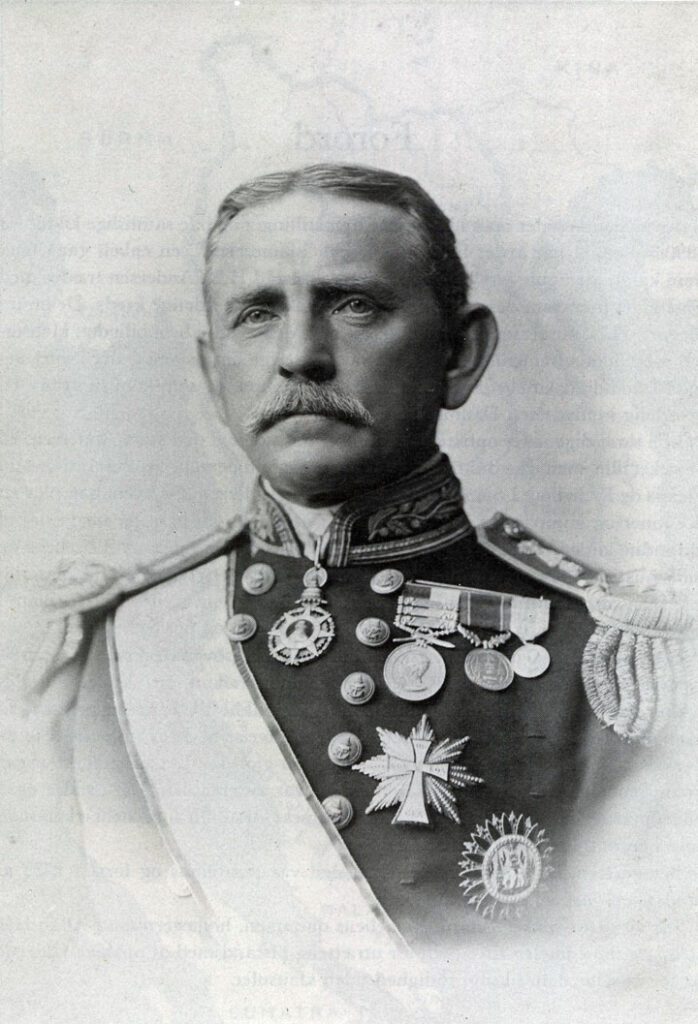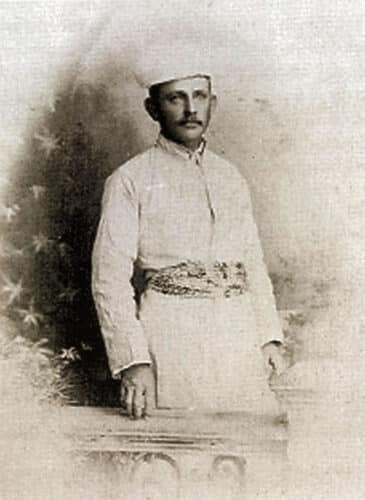Andreas du Plessis de Richelieu: farang, saber sharpener, capitalist opportunist & eminence grise

Admiral Andreas du Plessis de Richelieu
Today he is an almost forgotten historical figure, but Andreas du Plessis de Richelieu was once a not entirely uncontroversial farang in the Land of Smiles.
The man with this throbbing family name was born on February 24, 1852 in the Danish Loejt Kirkeby in the family of the local pastor. His family belonged to the tens of thousands of Huguenots who, after the revocation of the Edict of Nantes in 1685, had sought refuge in the Republic of the Seven United Provinces, the German lands, England, Scandinavia and even in the VOC colony at the Cape in South Africa. His ancestors had settled in Norway around 1690, but moved to Denmark weeks later. Du Plessis was the family name of the infamous French cardinal and statesman de Richelieu. Despite the fact that de Richelieu was added to the family name, there is no evidence of a family connection with l'éminence rouge.
When Andreas was registered as a pupil at the Cathedral School in Roskilde in 1864, the register stated that his father, the Reverend Louis du Plessis de Richelieu, had died at the age of 38 on St. Thomas, an unsightly island in the Caribbean that was occupied between 1672 and 1917. was a Danish colony, where – and this is quite remarkable – Dutch was the official language until the last half of the eighteenth century…. Andreas chose a career in the Danish Merchant Navy. He achieved the rank of Reserve Lieutenant in the Danish Navy when he Ship Master Certificate got.
But apparently this was not enough for this young and very ambitious Dane. During one of his long sea voyages he had arrived in Siam and apparently he liked his short stay in Bangkok so well that in the spring of 1873, barely 23 years old, he requested an audience with the Danish king Christian IX in Copenhagen . He asked and received from the king a letter of introduction for the Siamese king Chulalongkorn because he wanted to settle in Siam per se. Almost immediately after receiving this letter, he set sail for Singapore and from there departed for Bangkok. With help of men's Koebke, the Danish consul in the Siamese capital, Andreas du Plessis de Richelieu miraculously managed to arrange a personal meeting with King Chulalongkorn. It must have clicked immediately between these two young men because a few weeks later he was offered a job as an officer and second in command on one of the few Siamese warships. And it immediately became clear what meat the Siamese had in store, for Andrew refused the offer and demanded command of a ship. Perhaps a deliberate gamble, but it paid off because he was given command of HMSS Regent and called at Phuket on its maiden voyage along the west coast of Siam.
du Plessis de Richelieu was at that time one of an estimated 25 Danish naval officers serving in the Siamese fleet. Although the concept of fleet should be put into perspective because it consisted, in addition to four obsolete French gunboats and one warship that the Spaniards had refused, from the artillery-armed and seaworthy royal yacht Maha Chakri. He would soon rise in rank, partly because of the confidence the king placed in him, eventually commanding the royal yacht. Finally, between January 16, 1900 and January 29, 1901 to be exact, Andreas was the only non-Siamese to serve as Commander-in-Chief of the Siamese Royal Navy and Minister of the Navy. In recognition of his exceptional merits, Chulalongkorn not only elevated him to the rank of admiral but also bestowed upon him the honorary title of Phraya Chonlayutthayothin. Now say for yourself: Not bad for a merchant navy officer who had never obtained his international sailing license. And this despite the fact that he, along with his fellow Danish officers, had underperformed on July 13, 1893 during the so-called Paknam incident when French gunboats had broken through the Siamese defense lines on the Chao Phraya without much difficulty and with their guns directly attacked the royal palace.
du Plessis de Richelieu's greatest merits, however, did not lie in his involvement with the Siamese fleet, but everything to do with his nose for business. It all started in 1884. In that year he largely financed the ambitious plans of his compatriot, businessman and sea captain Hans Niels Andersen to build the first luxurious Western-style hotel in Bangkok. It oriental – that to this day, if it Mandarin Oriental upholds a solid reputation as a five-star hotel – opened its doors in 1887. Du Plessis de Richelieu acquired almost half of the shares in Andersen & Co, the later East Asian Company (EAC). In the course of the following years, EAC would become one of the largest players in the Southeast Asian market and play a key role in the industrialization of Siam and the highly profitable teak trade. In addition, du Plessis de Richelieu, thanks to his position in EAC, was given a very big finger in the creation of the Oriental Provision Store, which not only owned a store and warehouse for imported luxury goods, but quickly became one of the largest international supply companies in the country through a number of lucrative contracts with the Siamese Navy.

Du Plessis de Richelieu in Siamese dress
And it didn't stop there because our Danish navy man had boundless ambition and, as an above-average savvy businessman, created opportunities for economic expansion himself if necessary. He provided a first example of this when he built a 21 km long private railway between Paknam in the province of Samut Prakan and Bangkok. For a while it threatened to go wrong with the construction by underestimating the initial cost, but when King Chulalongkorn, his Danish friend, came to the rescue with an additional personal investment of 172.000 Baht, there was no longer any obstacle and this railway was opened in July. 1891 officially opened.
It was a hit and three years later, Chulalongkorn opened the first Dane-operated tram line in Bangkok that ran from the royal palace on Sanam Luang to the harbor in Klong Toey. But his most lucrative business was undoubtedly the establishment in 1898-1899 of the Siam Electric Company Ltd. who managed to negotiate an exclusivity contract for 50 years to supply the Siamese capital with electricity. Du Plessis de Richelieu had to work with the Country basket benches or Boerenbank in Copenhagen but it became an extremely profitable company, which was taken over in 1912 by a group of Belgian investors. It has never been made clear how many shares of du Plessis de Richelieu in the Siam Electric Company Ltd. but the takeover must have made him a huge profit… In 1907 a Danish newspaper made this public Siam Electric Company Ltd. and the tram line together, in that year alone, had realized a net profit of 1.200.000 Danish kroner – an immense fortune in those days.
And if all that wasn't enough, Chulalongkorn had in the meantime, in 1891, while accompanying Prince Damrong, the king's highly influential half-brother on a foreign trip to France, Denmark and Russia, appointed him royal quartermaster-general. This made him the main person responsible for supplying the Siamese armed forces. Coincidence or not, but in no time it was the Oriental again Provision Store, which won the most lucrative public contracts without formal award procedures.
But all good things must come to an end and shortly after the turn of the century a number of severe malaria attacks forced the Danish admiral not only to take it easy but also to look for other places. When du Plessis de Richelieu said goodbye to Siam in 1902 and returned with his wife and family to his native country, he turned out to have generated more wealth than the ten most important Danish bankers combined, and the latter were certainly no small shrimp. He bought Kokkedal Castle and withdrew from public life. But that was only an appearance because in reality he continued to participate actively, albeit in the background, in the world of the Scandinavian Haute Finance. For example, he was not only a member of the board of directors of EAC and chairman of the boards of directors of B&W Shipyard en DFDS Shipping as well as chairman of the board of directors of the Country basket benches. Only this last financial adventure ended badly for him, because when this bank went bankrupt in 1922, he was convicted of gross negligence a year later and fined 4.000 kroner by the Danish Supreme Court. He might then -perhaps- not have been related to l'eminence rouge, the Cardinal Richelieu, but in his last years he was very similar to his most important counselor, the Capuchin Father François Leclerc du Tremblay, who, due to his power politics, which is invisible to the uninitiated, is often referred to as l'eminence grise was described…
This remarkable farang died on March 25, 1932 in his opulent castle and was buried in a mausoleum in Holmens Kirke in Copenhagen.


“Today he is an almost forgotten historical figure, but Andreas du Plessis de Richelieu was once a not entirely controversial Farang in the Land of Smiles.”
Isn't "not entirely uncontroversial" meant?
Mea culpa… Of course this should not be entirely uncontroversial. I was a bit sloppy reading…
This article had to be written for the sounding name of that man alone.
Lung Jan introduces us to the international high society of the late 19th – early 20th century.
And the global ties such people had.
Even then they divided the world among themselves.
Nice time document.
And as always with Lung Jan, it reads like a train.
This is a very well documented and well written story.
In the XNUMXs, following my book on Gustave Rolin-Jaequemyns, I was approached by a distant Danish relative of the admiral asking for information. At the time, this person was – claimed to be – writing a book about the man. King Chulalongkorn's General Adviser has always kept his distance from other advisers of the Palace.
A single passing mention—I'm afraid I don't recall any of the thousands of documents I went through—showed that the admiral had played a major role in the crackdown on "rebellions" in the far south of Thailand. Uprisings that are echoed to this day.
Hence its controversy.
The Oriental Hotel, in this case the top floor, was also a kind of quarter where the Danes in the service of Siam stayed for years.
About the farangs from the North, Mary Laugesen, Poul Westphall and Robin Dannhorn wrote the book Scandinavians in Siam, edited by Niels Lumholdt, published by Thai Wattana Panich in 1980 with the financial contributions of some 40 companies – most of them with Scandinavian-sounding names.
The importance of this book is mainly due to the numerous photos, which one has to be careful about: dozens of non-Scandinavian farangs are also depicted.
I assume that Richelieu rock, one of the most beautiful dive sites in Thailand between Similan and Surin islands is named after him.
My publisher White Lotus Books reports that he still has 1 copy of Scandinavians in Siam for sale
https://www.whitelotusbooks.com/books/scandinavians-in-siam